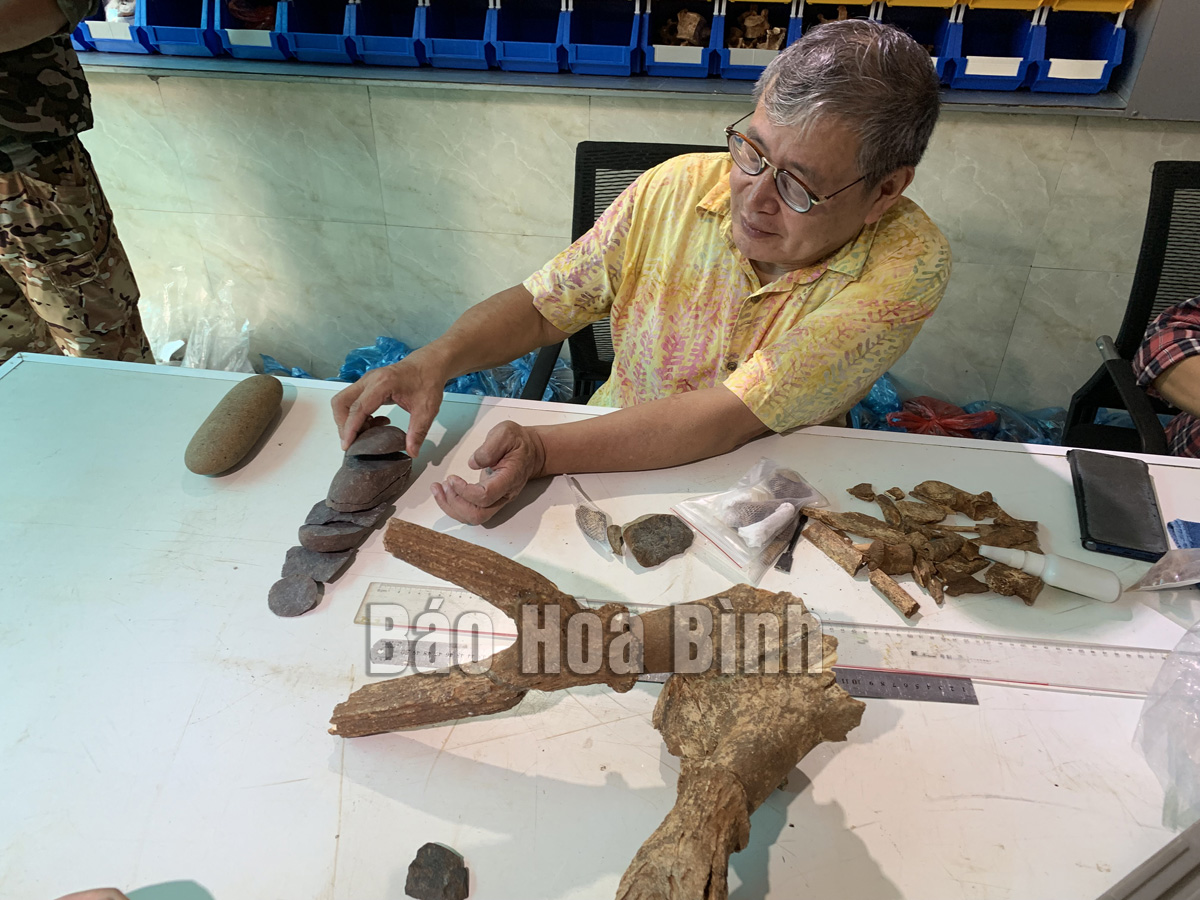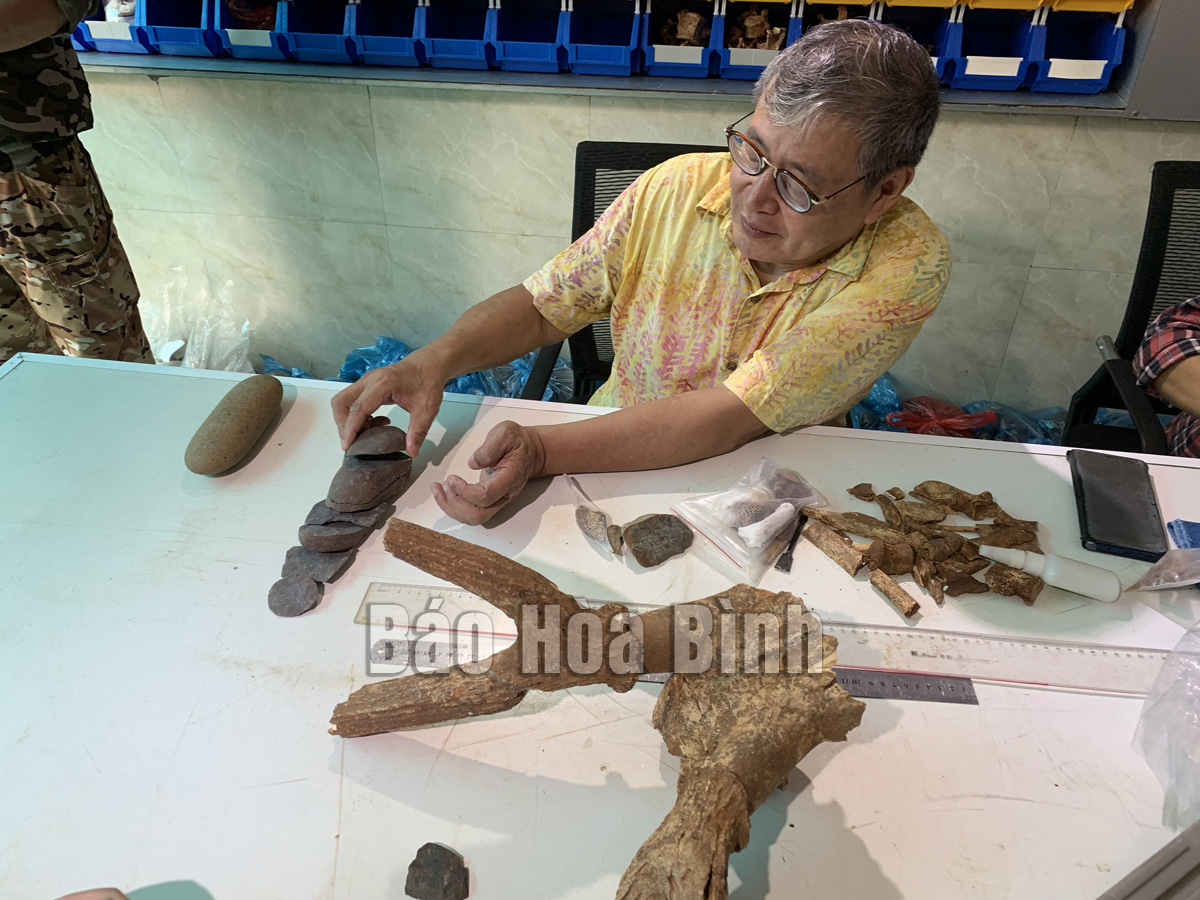
(HBO) – The Museum of Hoa Binh province has coordinated with the Centre for Southeast Asian Prehistoric Studies and the Vietnam Institute of Archaeology to excavate the Trai Hamlet cave and the Vanh Village stone shelter in Lac Son district, which are national archaeological relic sites and also home to diverse and outstanding items dating back to the Hoa Binh Civilisation.
Dr. Nguyen Viet, Director of the Centre for Southeast Asian Prehistoric Studies, introduces the items collected during the recent excavation of two archaeological sites in Lac Son district.
The excavation aimed to collect more scientific data about the Hoa Binh Civilisation in the province, gain an insight into the local history and culture, and serve display at the Provincial Museum.
The activity covered 50sq.m. at the Vanh Village stone shelter and 20sq.m. at the Trai Hamlet cave, collecting a number of stone and bone tools and burned rice grains.
Luu Huy Linh, Deputy Director of the provincial Department of Culture, Sports and Tourism, said the items have been sent to the Centre for Southeast Asian Prehistoric Studies for examining their age and value. Given the sites’ values, the department will propose the provincial People’s Committee work to seek the recognition of these places as special national relic sites and devise more measures for preserving and bringing into play their values.
The Trai Hamlet cave in Tan Lap commune was where the oldest vestiges of the Hoa Binh Civilisation in the Red River Delta were found. Discovered in 1975, this site has been excavated for many times by scientists. More than 5,000 objects have been collected since then, indicating that this was a long-term place of residence and also a tool making workshop of humans in the Hoa Binh Civilisation. So far, it is home to the most diverse stone and bone tools among the excavated relic sites of this civilisation. The cave could be classified as a site dating back to the early period of the New Stone Age.
Meanwhile, the Vanh Village stone shelter in Yen Phu commune was discovered by M. Colani in 1929. Research findings revealed by the French archaeologist in 1930 showed that this place dates back 17,000 - 18,000 years ago, which was the middle period of the Hoa Binh Civilisation.
Dr. Nguyen Viet, Director of the Centre for Southeast Asian Prehistoric Studies, said with the large number of tools, evidence of humans’ long-term residence, and the first fine art traces found in Vietnam, the Trai Hamlet cave and Vanh Village stone shelter could be recognised as special relic sites. All the items collected from these places will be handed over to and preserved at the Hoa Binh Provincial Museum to serve research and exhibition purposes to bring into play their values and meet the public’s demand./.
The clothing of women reflects the culture of the Muong, Thai, Tay, Dao, and Mong ethnic groups in the northern province of Hoa Binh.
Gongs hold a special place in the cultural and spiritual life of the Muong ethnic people in Hoa Binh province. More than musical instruments, they are an indispensable part of community rituals and collective memory, echoing through generations as a spiritual thread linking the past, present, and future.
Preserving and promoting the cultural values of the Muong ethnic group has become an urgent task in the current context, as many traditional values face the risk of fading away. This effort requires not only protecting the cultural identity but also eliminating outdated customs and developing a modern cultural lifestyle, contributing to sustainable values for the Muong community in Hoa Binh province.
The Muong ethnic culture, deeply rooted in Vietnam’s mountainous north, continues to be preserved and revitalised by dedicated individuals and communities determined to safeguard their ancestral identity.
The Muong group is one of the largest ethnic minorities in Vietnam, primarily found in Hoa Binh province. The Muong people in Hoa Binh boast a rich and diverse cultural treasure that reflects the unique identity of this ethnic group. Accounting for over 63% of the province's population, they have created and preserved numerous distinctive cultural values, contributing to their unique identity. Their cultural heritage is an invaluable asset, at the heart of their national identity, and represents a vibrant spiritual life that must be preserved and promoted in today’s modern world.
For generations, the ethnic communities of Hoa Binh province, particularly the Muong people, have preserved vibrant festivals deeply intertwined with the region’s geography, nature, and social traditions. These celebrations enrich Hoa Binh’s spiritual life and cultural identity, reflecting both folk beliefs and the intermingling of ethnic customs. Many of these festivals have endured the test of time, passed down through generations and continuing to thrive today. Among them, the Khai Ha (Going Down to the Field) festival stands out as one of the most significant events of the Muong ethnic group.



